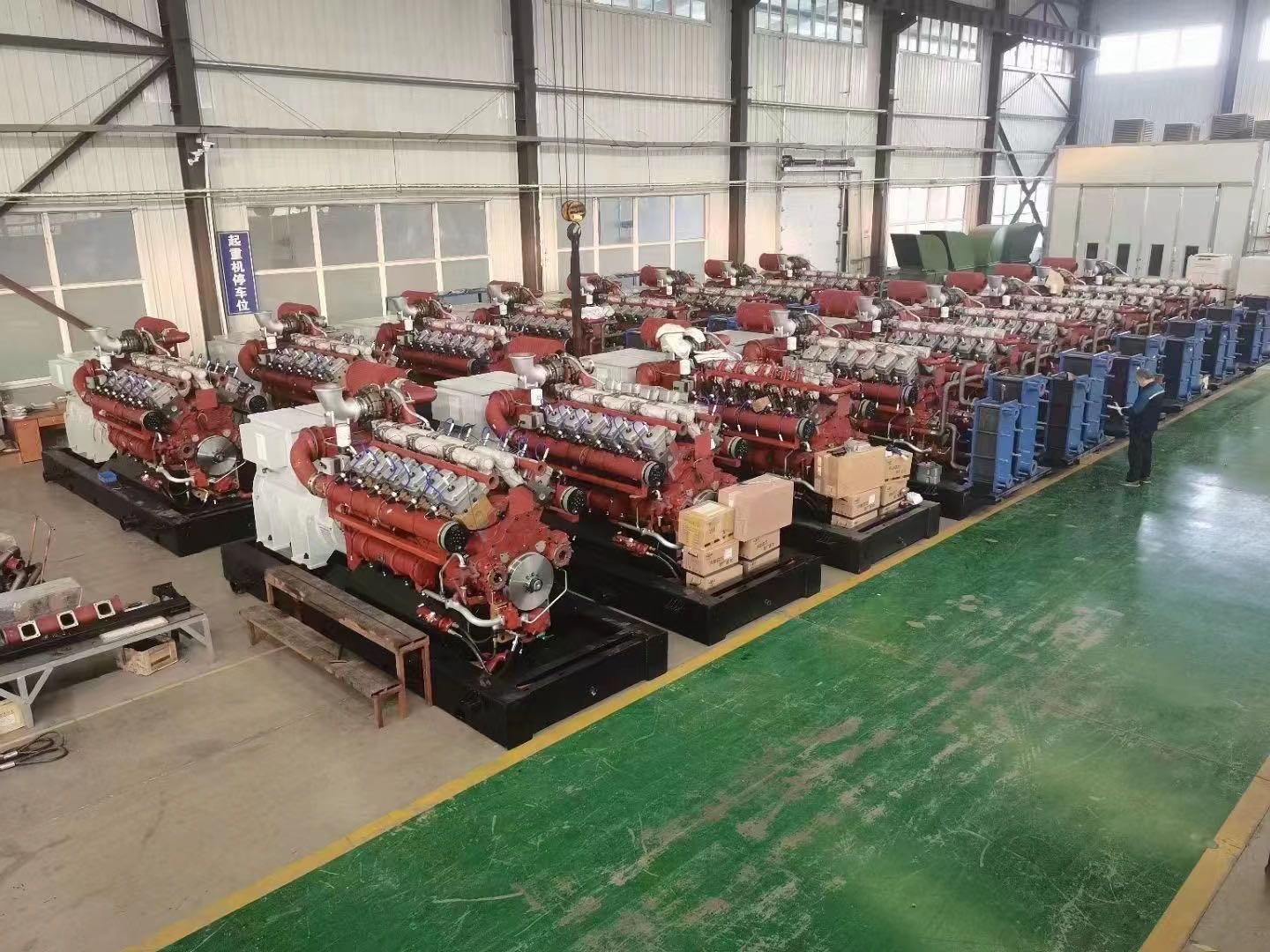 联系 - 热线
联系 - 热线

 联系 - 热线
联系 - 热线
煤气发电机组:能源高效转化的“绿色引擎”
煤气发电机组作为能源转换领域的重要设备,通过将煤气中的化学能转化为电能,为工业生产、城市供电及分布式能源系统提供了高效、清洁的解决方案。其技术核心在于燃气轮机或内燃机与发电机的集成应用,能够实现能源的梯级利用,减少碳排放。
As an important equipment in the field of energy conversion, gas generator sets provide efficient and clean solutions for industrial production, urban power supply, and distributed energy systems by converting the chemical energy in gas into electrical energy. The core of its technology lies in the integrated application of gas turbines or internal combustion engines with generators, which can achieve the cascading utilization of energy and reduce carbon emissions.
工作原理与技术架构
Working principle and technical architecture
煤气发电机组的核心由燃气处理系统、燃烧室、动力装置及发电机四部分构成。煤气首先经过净化处理,去除硫化物、粉尘等杂质,确保燃烧效率与设备寿命。随后,净化后的煤气进入燃烧室,与压缩空气混合后点燃,产生高温高压燃气。在燃气轮机中,燃气推动涡轮叶片旋转,带动同轴发电机发电;在内燃机中,燃气则通过活塞往复运动转化为机械能。例如,某型燃气轮机发电机组在满负荷运行时,燃气温度可达1300℃,推动涡轮每分钟旋转3000转,发电效率突破42%。
The core of a gas generator set consists of four parts: gas processing system, combustion chamber, power unit, and generator. Gas is first purified to remove impurities such as sulfides and dust, ensuring combustion efficiency and equipment lifespan. Subsequently, the purified gas enters the combustion chamber, mixes with compressed air, and ignites to produce high-temperature and high-pressure gas. In a gas turbine, gas drives the turbine blades to rotate, driving a coaxial generator to generate electricity; In internal combustion engines, gas is converted into mechanical energy through the reciprocating motion of pistons. For example, when a certain type of gas turbine generator set is operating at full load, the gas temperature can reach 1300 ℃, driving the turbine to rotate 3000 revolutions per minute, and the power generation efficiency exceeds 42%.
能源高效转化的“多面手”
A versatile expert in efficient energy conversion
煤气发电机组的优势在于其能源利用的灵活性与高效性。传统燃煤发电需经历煤炭开采、运输、破碎、燃烧等多个环节,能源损耗较大,而煤气发电机组可直接利用炼焦煤气、高炉煤气等工业副产气,减少能源浪费。例如,钢铁企业通过回收高炉煤气发电,可将自供电比例提升至60%以上,显著降低外购电成本。此外,机组采用模块化设计,可快速响应负荷变化,在分布式能源系统中实现冷热电三联供,综合能源利用率达80%以上。
The advantage of gas power generation units lies in their flexibility and efficiency in energy utilization. Traditional coal-fired power generation involves multiple processes such as coal mining, transportation, crushing, and combustion, resulting in significant energy loss. In contrast, gas generators can directly utilize industrial by-products such as coking gas and blast furnace gas to reduce energy waste. For example, steel companies can increase the proportion of self supplied electricity to over 60% by recycling blast furnace gas for power generation, significantly reducing the cost of purchasing electricity from external sources. In addition, the unit adopts modular design, which can quickly respond to load changes and achieve combined cooling, heating and power supply in distributed energy systems, with a comprehensive energy utilization rate of over 80%.

环保性能的“革新者”
Innovators in environmental performance
相比燃煤发电,煤气发电机组在环保方面表现卓越。煤气燃烧产生的二氧化硫、氮氧化物及颗粒物排放量远低于煤炭。例如,某煤气发电项目通过低氮燃烧技术与选择性催化还原(SCR)系统,将氮氧化物排放浓度控制在50毫克/立方米以下,达到超低排放标准。同时,机组采用余热锅炉回收烟气中的热量,用于蒸汽发电或供热,进一步减少能源浪费。
Compared to coal-fired power generation, gas-fired power generation units perform outstandingly in terms of environmental protection. The emissions of sulfur dioxide, nitrogen oxides, and particulate matter generated by coal gas combustion are much lower than those of coal. For example, a certain gas-fired power generation project uses low nitrogen combustion technology and selective catalytic reduction (SCR) system to control the concentration of nitrogen oxide emissions below 50 milligrams per cubic meter, achieving ultra-low emission standards. At the same time, the unit adopts a waste heat boiler to recover heat from the flue gas for steam power generation or heating, further reducing energy waste.
应用场景的“全能选手”
The 'all-around player' in application scenarios
煤气发电机组的应用领域广泛,涵盖钢铁、化工、建材等高耗能行业。在钢铁行业,高炉煤气、转炉煤气等副产气被用于发电,既解决废气排放问题,又降低企业能效成本。在化工领域,煤气发电机组可利用合成气、焦炉气等原料,实现能源自给自足。此外,机组还可作为分布式能源系统的核心设备,为工业园区、数据中心等提供稳定电力与热能,减少对传统电网的依赖。
The application fields of gas generator sets are extensive, covering high energy consuming industries such as steel, chemical, and building materials. In the steel industry, by-products such as blast furnace gas and converter gas are used for power generation, which not only solves the problem of exhaust emissions but also reduces the energy efficiency costs of enterprises. In the field of chemical engineering, gas generators can use raw materials such as synthetic gas and coke oven gas to achieve energy self-sufficiency. In addition, the unit can also serve as the core equipment of distributed energy systems, providing stable power and thermal energy for industrial parks, data centers, etc., reducing dependence on traditional power grids.
技术创新的“驱动力”
The driving force behind technological innovation
随着技术进步,煤气发电机组正朝着高效化、智能化方向发展。燃气轮机通过采用陶瓷基复合材料、3D打印叶片等技术,使涡轮进口温度提升至1600℃,发电效率突破60%。内燃机则通过米勒循环、涡轮增压等技术,实现热效率超过45%。同时,机组集成物联网与人工智能技术,可实时监测运行参数,预测设备故障,优化维护周期。例如,某智能煤气发电系统通过数据分析,将设备非计划停机率降低30%,维护成本减少20%。
With the advancement of technology, gas-fired power generation units are developing towards high efficiency and intelligence. Gas turbines use technologies such as ceramic based composite materials and 3D printed blades to increase the inlet temperature of the turbine to 1600 ℃ and achieve a power generation efficiency of over 60%. Internal combustion engines achieve thermal efficiency exceeding 45% through technologies such as Miller cycle and turbocharging. At the same time, the unit integrates Internet of Things and artificial intelligence technology, which can monitor operating parameters in real time, predict equipment failures, and optimize maintenance cycles. For example, a certain intelligent gas power generation system reduced unplanned equipment downtime by 30% and maintenance costs by 20% through data analysis.
未来趋势与挑战
Future Trends and Challenges
煤气发电机组的发展面临氢能融合、碳捕集利用与封存(CCUS)等新技术挑战。通过掺氢燃烧技术,机组可逐步过渡到氢能发电,实现零碳排放。同时,CCUS技术的应用可将机组排放的二氧化碳转化为化工原料,形成碳循环经济。然而,煤气成分波动、设备耐腐蚀性等问题仍需突破,需通过材料科学与控制技术的创新,进一步提升机组稳定性。
The development of gas-fired power generation units faces new technological challenges such as hydrogen integration and carbon capture, utilization, and storage (CCUS). Through hydrogen blending combustion technology, the unit can gradually transition to hydrogen power generation, achieving zero carbon emissions. At the same time, the application of CCUS technology can convert the carbon dioxide emitted by the unit into chemical raw materials, forming a carbon circular economy. However, issues such as fluctuations in gas composition and equipment corrosion resistance still need to be overcome, and innovation in material science and control technology is needed to further enhance the stability of the unit.
煤气发电机组以高效、清洁、灵活的特性,成为能源转型的关键设备。随着技术迭代与政策支持,其将在工业节能降碳、分布式能源建设等领域发挥更大作用,推动能源结构向绿色低碳转型。
Gas generator sets have become key equipment for energy transformation due to their high efficiency, cleanliness, and flexibility. With technological iteration and policy support, it will play a greater role in industrial energy conservation and carbon reduction, distributed energy construction, and other fields, promoting the transformation of energy structure towards green and low-carbon.
本文由煤气发电机组友情奉献.更多有关的知识请点击:http://www.zhongtuopower.cn我们将会对您提出的疑问进行详细的解答,欢迎您登录网站留言.
This article is a friendly contribution from the analysis of gas generator sets For more information, please click: http://www.zhongtuopower.cn We will provide detailed answers to your questions. You are welcome to log in to our website and leave a message
业务分类
Business classification产品推荐
product recommendation联系方式
Contact Information

截屏,微信识别二维码